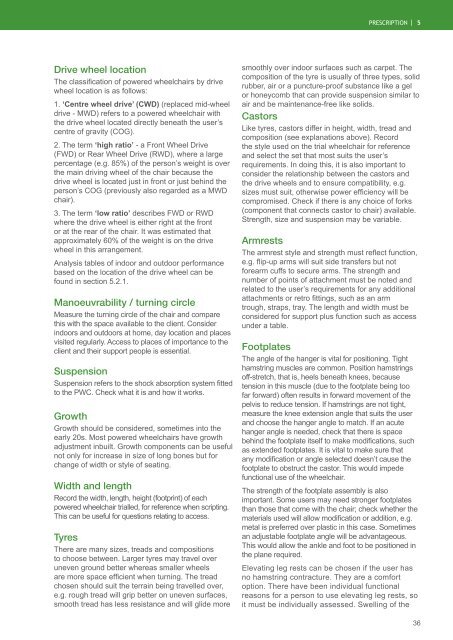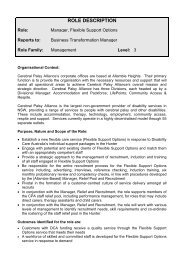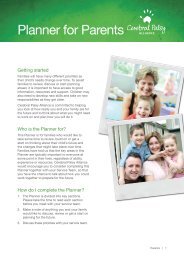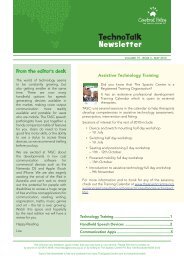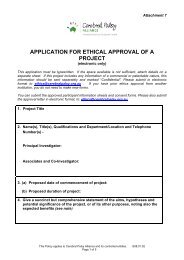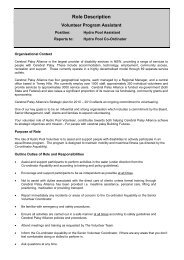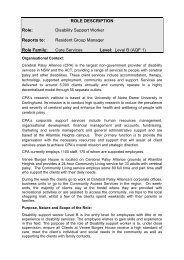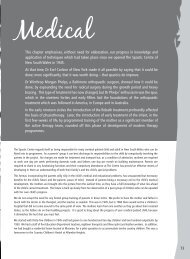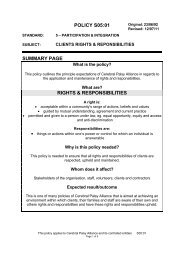Powered Mobility Manual - Cerebral Palsy Alliance
Powered Mobility Manual - Cerebral Palsy Alliance
Powered Mobility Manual - Cerebral Palsy Alliance
- No tags were found...
Create successful ePaper yourself
Turn your PDF publications into a flip-book with our unique Google optimized e-Paper software.
PRESCRIPTION | 5Drive wheel locationThe classification of powered wheelchairs by drivewheel location is as follows:1. ‘Centre wheel drive’ (CWD) (replaced mid-wheeldrive - MWD) refers to a powered wheelchair withthe drive wheel located directly beneath the user’scentre of gravity (COG).2. The term ‘high ratio’ - a Front Wheel Drive(FWD) or Rear Wheel Drive (RWD), where a largepercentage (e.g. 85%) of the person’s weight is overthe main driving wheel of the chair because thedrive wheel is located just in front or just behind theperson’s COG (previously also regarded as a MWDchair).3. The term ‘low ratio’ describes FWD or RWDwhere the drive wheel is either right at the frontor at the rear of the chair. It was estimated thatapproximately 60% of the weight is on the drivewheel in this arrangement.Analysis tables of indoor and outdoor performancebased on the location of the drive wheel can befound in section 5.2.1.Manoeuvrability / turning circleMeasure the turning circle of the chair and comparethis with the space available to the client. Considerindoors and outdoors at home, day location and placesvisited regularly. Access to places of importance to theclient and their support people is essential.SuspensionSuspension refers to the shock absorption system fittedto the PWC. Check what it is and how it works.GrowthGrowth should be considered, sometimes into theearly 20s. Most powered wheelchairs have growthadjustment inbuilt. Growth components can be usefulnot only for increase in size of long bones but forchange of width or style of seating.Width and lengthRecord the width, length, height (footprint) of eachpowered wheelchair trialled, for reference when scripting.This can be useful for questions relating to access.TyresThere are many sizes, treads and compositionsto choose between. Larger tyres may travel overuneven ground better whereas smaller wheelsare more space efficient when turning. The treadchosen should suit the terrain being travelled over,e.g. rough tread will grip better on uneven surfaces,smooth tread has less resistance and will glide moresmoothly over indoor surfaces such as carpet. Thecomposition of the tyre is usually of three types, solidrubber, air or a puncture-proof substance like a gelor honeycomb that can provide suspension similar toair and be maintenance-free like solids.CastorsLike tyres, castors differ in height, width, tread andcomposition (see explanations above). Recordthe style used on the trial wheelchair for referenceand select the set that most suits the user’srequirements. In doing this, it is also important toconsider the relationship between the castors andthe drive wheels and to ensure compatibility, e.g.sizes must suit, otherwise power efficiency will becompromised. Check if there is any choice of forks(component that connects castor to chair) available.Strength, size and suspension may be variable.ArmrestsThe armrest style and strength must reflect function,e.g. flip-up arms will suit side transfers but notforearm cuffs to secure arms. The strength andnumber of points of attachment must be noted andrelated to the user’s requirements for any additionalattachments or retro fittings, such as an armtrough, straps, tray. The length and width must beconsidered for support plus function such as accessunder a table.FootplatesThe angle of the hanger is vital for positioning. Tighthamstring muscles are common. Position hamstringsoff-stretch, that is, heels beneath knees, becausetension in this muscle (due to the footplate being toofar forward) often results in forward movement of thepelvis to reduce tension. If hamstrings are not tight,measure the knee extension angle that suits the userand choose the hanger angle to match. If an acutehanger angle is needed, check that there is spacebehind the footplate itself to make modifications, suchas extended footplates. It is vital to make sure thatany modification or angle selected doesn’t cause thefootplate to obstruct the castor. This would impedefunctional use of the wheelchair.The strength of the footplate assembly is alsoimportant. Some users may need stronger footplatesthan those that come with the chair; check whether thematerials used will allow modification or addition, e.g.metal is preferred over plastic in this case. Sometimesan adjustable footplate angle will be advantageous.This would allow the ankle and foot to be positioned inthe plane required.Elevating leg rests can be chosen if the user hasno hamstring contracture. They are a comfortoption. There have been individual functionalreasons for a person to use elevating leg rests, soit must be individually assessed. Swelling of the36


